
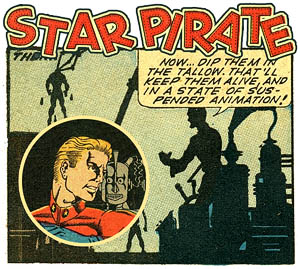 Hot off the web pages of Golden Age Comic Book Stories is this eight page story by Murphy Anderson, from Planet Comics in 1945.
Hot off the web pages of Golden Age Comic Book Stories is this eight page story by Murphy Anderson, from Planet Comics in 1945.
I have to admit I’m not sure why our hero’s actually named Star Pirate, why he hangs out with an obese space pirate named Blackbeard, or whether he actually is a pirate. He seems like a pretty straight arrow to me.
But none of that’s very important when you discover that you’re in a world where towering robots buy all the slaves at a slave auction and almost no one is curious about why they want them; or when you find that there’s a mad scientist at work, which of course is reassuring – but most importantly, we learn here that dipping people in tallow will preserve them in a state of suspended animation. Hot? Yes. Disgusting? You bet. But oh, so useful.
The story spans two posts on this page.
This entry was posted on Wednesday, February 27th, 2008
and was filed under Found on the Web
There have been no responses »
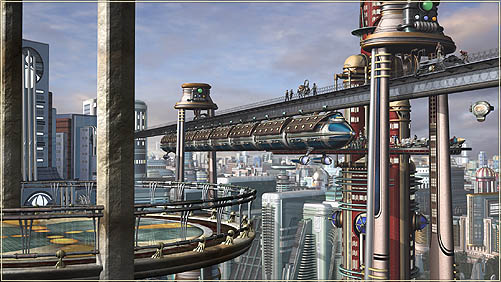
All may seem quiet around here, but in fact I’ve been working steadily on this image (which I posted about earlier, here and here). Although I’ve thought about posting some more updates, I haven’t. All of this new work has been on distant elements, and then the monorail terminal and the sixteen characters who are getting off (or on) the monorail, or working up on its track (see the inset at right). Because of the relative size of all those things they’re scarcely visible when the whole picture is scaled down from over 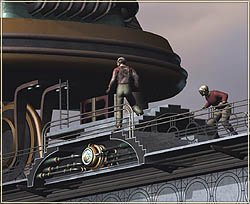 7000 pixels wide to this size, 501 pixels wide. So it’d have been almost pointless to try to keep you up to date. There’d have been very little obvious change.
7000 pixels wide to this size, 501 pixels wide. So it’d have been almost pointless to try to keep you up to date. There’d have been very little obvious change.
As of this afternoon, though, I’ve got the far and middle distance more or less set; I’ve done the final (or semifinal) renderings of the three scenes that so far are composited together here, and I’ve added a sort of poor man’s depth of field effect on the distant cityscape.
Although there will be quite a bit of retouching to do in Photoshop, everything you see behind the foreground balcony is in a semifinal state. So I thought I ought to post an update now, before I start working on the foreground.
I had some difficulties with the way 3DS Max does its render effects and rendering passes. The first problem was that I was getting unpredictable results from the Z Depth pass. That’s an additional rendering that uses greyscale to show how far from the camera everything in the picture is – it can be very useful for creating masked effects, like depth of field, in post.
So to get around that, I’ve created a Z Depth pass in a sort of handmade way, using the free Bytegeist “ZTint” plugin for Max. I rendered out a Z Depth version of each scene and combined them together in Photoshop (see below). By using the exact same settings in each rendered layer I’ve built up my own Z Depth version of the background. It makes a geat mask for adding efects to the entire scene in Photoshop, based on their distance from my camera.
In order to get what you see below I applied a white, self-illuminated material to every visible object. The ZTint render effect added black to the object color depending on its distance.
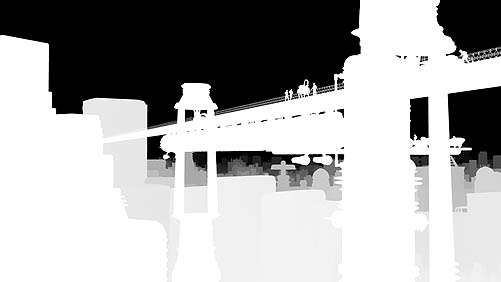
It turns out that it was a good idea to avoid Max’s render elements, because another problem I ran into was that when network rendering the scene in strips – which conserved memory while these very large images were rendering – the additional rendering passes were not rendered correctly.
The main image rendered out in ten strips which were then stitched together at the end. But additional render passes like Z Depth or a specularity pass were never completed in the same way: each strip just overwrote the previous one and they were never assembled together, since only one tenth of them existed at the end anyhow. Annoying.
I’m still using Max 8, so I don’t know if that bug’s been fixed in the more recent versions.
Anyway, it’s now time to turn my attention to all the work I have yet to do on that balcony in the foreground and the characters there. I don’t have any real idea of how long those bits – and the final compositing and post work – will take, but I figure it’ll easily be another couple of weeks before this is done. Luckily for me, I’m not working to a deadline!
This entry was posted on Thursday, February 21st, 2008
and was filed under Computer Graphics, Works in Progress
There has been 1 Response »
Now if we were to quibble, we might call this a Laser Lyre rather than a Laser Harp: it’s got a limited range, and the arrangement of the “strings” is more lyre-like than harp-like. But we don’t get to quibble because we aren’t clever enough to build one ourselves, are we?
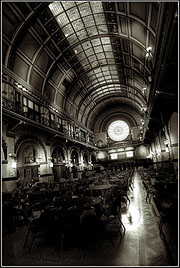 This is the brainchild of Stephen Hobley, a photographer from Indianapolis. The “Laser Harp” is one of his side projects – another was the conversion of a player piano into a computer case.
This is the brainchild of Stephen Hobley, a photographer from Indianapolis. The “Laser Harp” is one of his side projects – another was the conversion of a player piano into a computer case.
Hobley has posted a brief tour of the Laser Harp’s workings here, with more information at his blog. And while you’re there, don’t miss his photographs of Indianapolis’ decaying Union Station – really nice stuff there!
This entry was posted on Friday, February 15th, 2008
and was filed under Found on the Web
There have been no responses »

One nice thing (well, sometimes) about rendering tests is that for a few minutes at a time, I’ve got nothing to do. Now in fact that’s often frustrating, but not always – for example, now. Look what I found – here are some cool  slumped glass night lights and other gewgaws from the workshop of my aunt, Paulette Martin. Love that Kokopelli!
slumped glass night lights and other gewgaws from the workshop of my aunt, Paulette Martin. Love that Kokopelli!
Paulette’s off in the southwest, which has seeped into some of her work with its patterns and themes. Her Smugmug account has photos of these objects and loads more, including lamps , vases, and window pieces.
This entry was posted on Wednesday, February 13th, 2008
and was filed under Found on the Web
There have been 2 Responses »
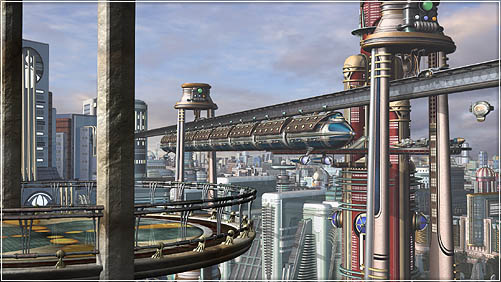
I continue my struggle to show you things that aren’t ready for your eyeballs yet with the current state of my (still to be named) retro futuristic city scene. I’ve made one pass through the middle distance, and a long pass through the distant city, and today I’m back in the middle distance again.
This is the first practical use I’ve made of the city model I started ages ago and worked on again during the fall. It’s interesting to see how I’ve come to use it. Because the city itself is built out of large, complex sections, it was simple enough to drop a complete copy into my 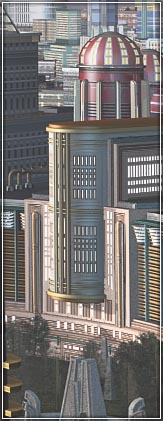 background here. The surprising things happened when I tried to make a picture out of it; like Raymond Loewy’s revision of the Lucky Strike cigarette pack, the real trick was in figuring out what to throw away. So while I did plenty of moving, scaling, and rotating of individual buildings, more than anything else I had to decide which ones to delete completely in order to open up the vista in a way that served the picture.
background here. The surprising things happened when I tried to make a picture out of it; like Raymond Loewy’s revision of the Lucky Strike cigarette pack, the real trick was in figuring out what to throw away. So while I did plenty of moving, scaling, and rotating of individual buildings, more than anything else I had to decide which ones to delete completely in order to open up the vista in a way that served the picture.
I added a lot of detail to the monorail pylons and created catwalks that run their length. There’ll be a few workers up there soon. But today I’m positioning some shadow-casting silhouettes that create the illusion that more buildings, out of the frame, are casting shadows across the ones we see close up. There’s a lot of trial and error involved in that. Like there is, um, in everything else.
I’m still handling the scene in three separate layers. Once I combined the far and middle distance into a single scene the rendering times increased pretty dramatically – and having them all together didn’t actually solve any problem I needed to solve – so I split them apart again. Go figure.
One little tool that was all sorts of help here is Martin Breidt’s Image Overlay script for 3DS Max. It’s really meant to superimpose frame numbers and other data on renderings, but it’ll also do a quick image overlay. I’m using it to drop in whole layers (like a Targa image of the foreground balcony) so that I can see how the layers stack up, while I’m just working on one. A back layer’s easy – it’s just an environment map – but it’s been really helpful to composite that foreground in as I go, too.
This entry was posted on Monday, February 11th, 2008
and was filed under Computer Graphics, Works in Progress
There have been no responses »
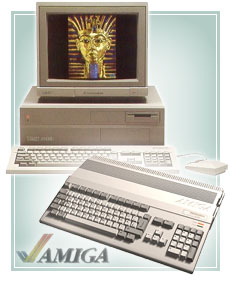 Part 6 of Ars Technica’s excellent History of the Amiga Computer is now online. It takes us through the tumultuous and important years of 1986 and 1987 and – as always – tells the story of some very smart moves which – as always – are completely negated by bizarre corporate decisions. On the block this time are large parts of Commodore’s own engineering staff, who began to design the new Amiga models, along with Commodore’s new CEO Thomas Rattigan.
Part 6 of Ars Technica’s excellent History of the Amiga Computer is now online. It takes us through the tumultuous and important years of 1986 and 1987 and – as always – tells the story of some very smart moves which – as always – are completely negated by bizarre corporate decisions. On the block this time are large parts of Commodore’s own engineering staff, who began to design the new Amiga models, along with Commodore’s new CEO Thomas Rattigan.
In order to follow up the soft launched Amiga 1000 Rattigan decided to split the Amiga line into a high and low end model. He felt that the Amiga 1000 fell at a price point the market didn’t understand (too high for a consumer computer, too low for a business computer) and the Amiga 500 and 2000 were meant to fix that by giving each market a machine to love.
Apart from their form factor and expandability they were essentially the same machine, which meant – to me, and to artists like me – that the Amiga 500 made a perfect entry level system, especially when its RAM was expanded to one, count it, one megabyte. That was considered a crazy amount of RAM in those days. We also meet Trip Hawkins, founder of Electronic Arts, and Dan Silva, author of the seminal paint program Deluxe Paint.
I’ve been enjoying these articles all along but it’s getting more exciting to me here because this is about where I arrived. Good reading.
If you missed them, here are the earlier chapters:
This entry was posted on Monday, February 11th, 2008
and was filed under Computer Graphics, Found on the Web
There have been no responses »
Vivian Heller’s The City Beneath Us is a wonderful book from the New York Transit Museum, full of period photographs and information about the construction of the three lines that eventually merged to become the single New York subway system.
is a wonderful book from the New York Transit Museum, full of period photographs and information about the construction of the three lines that eventually merged to become the single New York subway system.
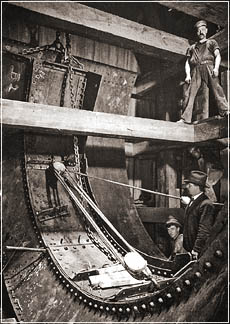 I’m especially interested in the appearance of the tunnels during the 20’s and 30’s, as part of the research for a gigantic personal project of mine. Heller’s book doesn’t disappoint there, but I found that I was captivated by the wealth of historic detail about the struggles to create and maintain the system – first opposed by those who thought it was impossible or ill-advised, and later plagued by the political impossibility of raising the nickel fare – which lasted for nearly 45 years – so that the system could be properly maintained and expanded.
I’m especially interested in the appearance of the tunnels during the 20’s and 30’s, as part of the research for a gigantic personal project of mine. Heller’s book doesn’t disappoint there, but I found that I was captivated by the wealth of historic detail about the struggles to create and maintain the system – first opposed by those who thought it was impossible or ill-advised, and later plagued by the political impossibility of raising the nickel fare – which lasted for nearly 45 years – so that the system could be properly maintained and expanded.
I was amazed to learn that the short test run of a pneumatic subway was constructed secretly (and illegally!) before 1870. That’s how desperate the city was to give its immigrant population some means of getting out of the overcrowded tenements of lower Manhattan – one of the prime motivations behind a public transportation system.
The three lines were built using several different techniques, depending on the composition of the land they were cutting through. While tunnels were driven through rocky sections, a “cut and cover” technique was used wherever possible. Utility lines (already a labyrinth beneath the city) had to be rerouted so that trenches could be cut below the streets and then covered over, the streets being restored above the heads of the workers who then completed the work. Where stone was removed from the tunnels it was moved, with carts, cars, and mules, and crushed so that it could become part of the concrete that formed so much of the tunnel lining. This work was largely done at the turn of the twentieth century and the engineers worked brilliantly within the limits of their technology.

The design itself was so good that even after the collapse of the Twin Towers on 9/11 there was little damage to the tunnels except where they passed closest to the World Trade Center. When those tunnels were rebuilt, the modern engineers made only minor modifications to the hundred year old bracing design that had worked so well.
Likewise the construction of the subway lines that passed underwater used techniques that are very similar to those used in the trans-Bosporus tunnel now being built in Istanbul. Whatever else you can say about the turn of the 20th century, those were days in which builders rightly believed that they could accomplish just about anything.
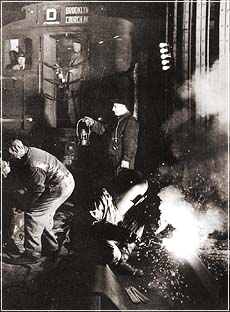 Like any public transit system the New York subway has had its rough times, its encounters with bankruptcy, its intrigues, and its rebirths. It’s where Heller’s book deals with Robert Moses that I just had to smile. Moses is a polarizing figure in New York history and he was no friend to public transportation. When I’ve read about Moses’ role in the creation of the 1939 New York Worlds’ Fair, he’s described as a visionary – but because so much of that vision was based on the automobile and its highways he’s very nearly demonized here. He is always a figure who seems larger than life, either way – though from this 21st century vantage I have to lean toward the Transit Museum’s view of him. New York would have been far better served through the improvement and expansion of its public transit.
Like any public transit system the New York subway has had its rough times, its encounters with bankruptcy, its intrigues, and its rebirths. It’s where Heller’s book deals with Robert Moses that I just had to smile. Moses is a polarizing figure in New York history and he was no friend to public transportation. When I’ve read about Moses’ role in the creation of the 1939 New York Worlds’ Fair, he’s described as a visionary – but because so much of that vision was based on the automobile and its highways he’s very nearly demonized here. He is always a figure who seems larger than life, either way – though from this 21st century vantage I have to lean toward the Transit Museum’s view of him. New York would have been far better served through the improvement and expansion of its public transit.
The text runs for just 81 of the book’s 245 pages – the rest is given over completely to the vintage photographs that introduce us to the workmen and sites that, street by street and borough by borough, gradually knit themselves together into a functioning network that now carries people rapidly and reliably through all of Manhattan and its outlying areas. And while that complete process took decades it’s still true that its original framework – the IRT line – came together in just the first four years of the 20th century, at a time when the city was growing and changing at an unprecedented rate. Mounting and completing such a major project in the middle of that growth and change was – and remains – a staggering achievement.
The City Beneath Us – Building the New York Subways at Amazon.
at Amazon.
This entry was posted on Thursday, February 7th, 2008
and was filed under Reading / Watching / Consuming
There have been no responses »
I’ve never liked showing work in progress*, and I can prove it.
Though I don’t remember this myself I have it on the best authority that as an infant, I just wouldn’t talk. Just wouldn’t. They were actually getting sort of worried about me, till one day I fell down and hurt my head badly enough that blood poured all over my face, and before I could stop myself, I yelled “Get this stuff offa me!”
The first thing I ever said was a complete sentence. The way I figure it, I wasn’t going to say a word to anyone until I’d conjugated everything that could be conjugated in my head so that no one could hear me make a mistake. True story.
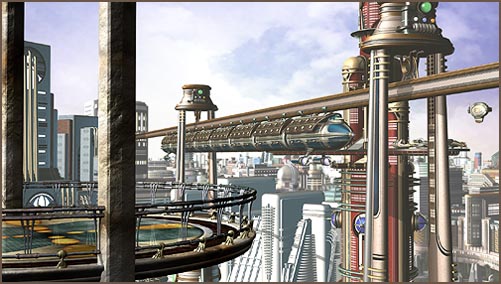
So obviously that means I’d rather not let you see things that aren’t finished, except that’s stupid, so here’s one that’s a long ways from being finished yet. It’s so unfinished that it doesn’t have a name. I usually name these after the titles of, or lines from, popular songs of the 20s and 30s, and though I have a few ideas I’m not sure yet what it’ll be called.
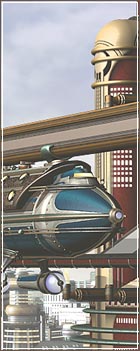 I’m combining a lot of elements here that I’ve built during the past eight years (which means some of them need some retooling; I spent some time reworking the monorail pylons, for example, which are just so dang big in this picture) along with some new stuff. The new bits are/will be mainly in the near foreground, where some of my newest Retropolitan characters will appear in their glorious high res-ness.
I’m combining a lot of elements here that I’ve built during the past eight years (which means some of them need some retooling; I spent some time reworking the monorail pylons, for example, which are just so dang big in this picture) along with some new stuff. The new bits are/will be mainly in the near foreground, where some of my newest Retropolitan characters will appear in their glorious high res-ness.
And though at the moment it’s arranged as three separate scenes – eventually, it’ll probably be two – I’m having a wonderful and a very relieved time spreading out into the new memory space that’s available to me now that I’ve finally gone over to a 64 bit OS. There are frequent sighs of relief here in the Secret Laboratory.
I’ve got tons to do on… well, practically everything… but the highlights will be the people on the balcony and what they’re up to, some folks debarking from the monorail, and more, some of which will come as a surprise to me.
The distant buildings are part of my ongoing city model, a necessary and huge asset for my “Empire State Patrol” project. Miles to go before I sleep, and all that.
I’d been planning for this to end up as about an 18 x 24″ poster and print, but it’s shaping up so well that I think I may do the final version larger… about 20 x 30″.
=================================
*So why do I have a “Works in Progress” category here in the blog? Because it’s never too late to change.
This entry was posted on Saturday, February 2nd, 2008
and was filed under Computer Graphics, Works in Progress
There have been no responses »

 Hot off the web pages of Golden Age Comic Book Stories is this eight page story by Murphy Anderson, from Planet Comics in 1945.
Hot off the web pages of Golden Age Comic Book Stories is this eight page story by Murphy Anderson, from Planet Comics in 1945.






 7000 pixels wide to this size, 501 pixels wide. So it’d have been almost pointless to try to keep you up to date. There’d have been very little obvious change.
7000 pixels wide to this size, 501 pixels wide. So it’d have been almost pointless to try to keep you up to date. There’d have been very little obvious change.








 background here. The surprising things happened when I tried to make a picture out of it; like Raymond Loewy’s revision of the Lucky Strike cigarette pack, the real trick was in figuring out what to throw away. So while I did plenty of moving, scaling, and rotating of individual buildings, more than anything else I had to decide which ones to delete completely in order to open up the vista in a way that served the picture.
background here. The surprising things happened when I tried to make a picture out of it; like Raymond Loewy’s revision of the Lucky Strike cigarette pack, the real trick was in figuring out what to throw away. So while I did plenty of moving, scaling, and rotating of individual buildings, more than anything else I had to decide which ones to delete completely in order to open up the vista in a way that served the picture.


 I’m especially interested in the appearance of the tunnels during the 20’s and 30’s, as part of the research for a gigantic personal project of mine. Heller’s book doesn’t disappoint there, but I found that I was captivated by the wealth of historic detail about the struggles to create and maintain the system – first opposed by those who thought it was impossible or ill-advised, and later plagued by the political impossibility of raising the nickel fare – which lasted for nearly 45 years – so that the system could be properly maintained and expanded.
I’m especially interested in the appearance of the tunnels during the 20’s and 30’s, as part of the research for a gigantic personal project of mine. Heller’s book doesn’t disappoint there, but I found that I was captivated by the wealth of historic detail about the struggles to create and maintain the system – first opposed by those who thought it was impossible or ill-advised, and later plagued by the political impossibility of raising the nickel fare – which lasted for nearly 45 years – so that the system could be properly maintained and expanded.

 Like any public transit system the New York subway has had its rough times, its encounters with bankruptcy, its intrigues, and its rebirths. It’s where Heller’s book deals with Robert Moses that I just had to smile. Moses is a polarizing figure in New York history and he was no friend to public transportation. When I’ve read about Moses’ role in the creation of the 1939 New York Worlds’ Fair, he’s described as a visionary – but because so much of that vision was based on the automobile and its highways he’s very nearly demonized here. He is always a figure who seems larger than life, either way – though from this 21st century vantage I have to lean toward the Transit Museum’s view of him. New York would have been far better served through the improvement and expansion of its public transit.
Like any public transit system the New York subway has had its rough times, its encounters with bankruptcy, its intrigues, and its rebirths. It’s where Heller’s book deals with Robert Moses that I just had to smile. Moses is a polarizing figure in New York history and he was no friend to public transportation. When I’ve read about Moses’ role in the creation of the 1939 New York Worlds’ Fair, he’s described as a visionary – but because so much of that vision was based on the automobile and its highways he’s very nearly demonized here. He is always a figure who seems larger than life, either way – though from this 21st century vantage I have to lean toward the Transit Museum’s view of him. New York would have been far better served through the improvement and expansion of its public transit.


 I’m combining a lot of elements here that I’ve built during the past eight years (which means some of them need some retooling; I spent some time reworking the monorail pylons, for example, which are just so dang big in this picture) along with some new stuff. The new bits are/will be mainly in the near foreground, where some of my newest Retropolitan characters will appear in their glorious high res-ness.
I’m combining a lot of elements here that I’ve built during the past eight years (which means some of them need some retooling; I spent some time reworking the monorail pylons, for example, which are just so dang big in this picture) along with some new stuff. The new bits are/will be mainly in the near foreground, where some of my newest Retropolitan characters will appear in their glorious high res-ness.